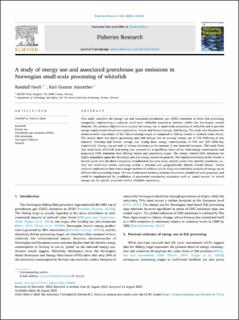| dc.contributor.author | Høyli, Randulf | |
| dc.contributor.author | Aarsæther, Karl Gunnar | |
| dc.date.accessioned | 2023-10-06T11:48:42Z | |
| dc.date.available | 2023-10-06T11:48:42Z | |
| dc.date.created | 2023-08-31T20:13:40Z | |
| dc.date.issued | 2023 | |
| dc.identifier.citation | Fisheries Research. 2023, 268, 106842. | en_US |
| dc.identifier.issn | 0165-7836 | |
| dc.identifier.uri | https://hdl.handle.net/11250/3094960 | |
| dc.description.abstract | This study considers the energy use and associated greenhouse gas (GHG) emissions at three fish processing companies, representing a seasonal small-scale whitefish processing industry within the Norwegian coastal fisheries. The primary objective is to analyse the energy use in small-scale processing of whitefish and to provide energy requirements for primary processing, freezer and freezer storage, and drying. The study also discusses the environmental importance of the fish processing stages as compared to fishing vessels in seafood value chains. The results show that initial processing and cold storage has an average energy use of 132 kWh/ton of raw material. Freezing and freezer storage and drying have energy consumptions of 449 and 203 kWh/ton, respectively. Energy use per unit of volume decreases as the amount of raw material increases. This study finds that small-scale whitefish processing may account for a significant share of the total energy consumption and associated GHG emissions from fishing vessels and processing stages. The energy related GHG emissions are highly dependent upon the electricity mix and energy sources in general. The representativeness of the results is limited given that the three companies considered in this case study operate under very specific conditions, i.e., they are small-scale actors operating within a seasonal and geographically limited coastal fishery. Future research could utilize data from a larger number of facilities and do long-term statistical analysis of energy use in different fish processing stages. The use of advanced metering systems has proven suitable for such purposes, and could be supplemented by installation of permanent monitoring equipment such as “panel servers” to record energy use for specific processes within whitefish processing. | en_US |
| dc.language.iso | eng | en_US |
| dc.publisher | Elsevier | en_US |
| dc.rights | Navngivelse 4.0 Internasjonal | * |
| dc.rights.uri | http://creativecommons.org/licenses/by/4.0/deed.no | * |
| dc.title | A study of energy use and associated greenhouse gas emissions in Norwegian small-scale processing of whitefish | en_US |
| dc.title.alternative | A study of energy use and associated greenhouse gas emissions in Norwegian small-scale processing of whitefish | en_US |
| dc.type | Peer reviewed | en_US |
| dc.type | Journal article | en_US |
| dc.description.version | publishedVersion | en_US |
| dc.rights.holder | © 2023 The Author(s). Published by Elsevier B.V. | en_US |
| dc.source.volume | 268 | en_US |
| dc.source.journal | Fisheries Research | en_US |
| dc.identifier.doi | 10.1016/j.fishres.2023.106842 | |
| dc.identifier.cristin | 2171491 | |
| dc.source.articlenumber | 106842 | en_US |
| cristin.ispublished | true | |
| cristin.fulltext | original | |
| cristin.qualitycode | 1 | |

